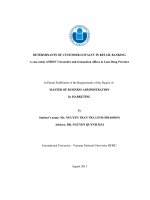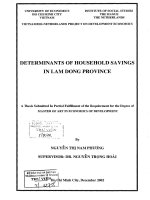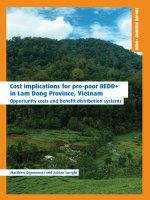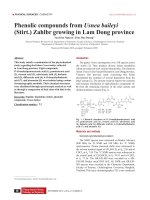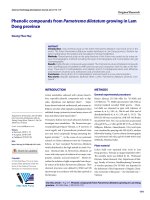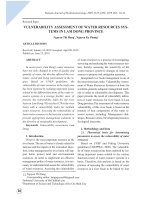Determinants of customer loyalty in retail banking a case study of BIDVs branches and transaction offices in lam dong province
Bạn đang xem bản rút gọn của tài liệu. Xem và tải ngay bản đầy đủ của tài liệu tại đây (3.31 MB, 134 trang )
DETERMINANTS OF CUSTOMER LOYALTY IN RETAIL BANKING
A case study of BIDV’s branches and transaction offices in Lam Dong Province
In Partial Fulfillment of the Requirements of the Degree of
MASTER OF BUSINESS ADMINISTRATION
In MARKETING
By
Student’s name: Ms: NGUYEN TRAN TRA LINH (MBA04019)
Advisor: DR. NGUYEN QUYNH MAI
International University - Vietnam National University HCMC
August 2013
DETERMINANTS OF CUSTOMER LOYALTY IN RETAIL BANKING
A case study of BIDV’s branches and transaction offices in Lam Dong Province
In Partial Fulfillment of the Requirements of the Degree of
MASTER OF BUSINESS ADMINISTRATION
In MARKETING
By
Ms: Nguyen Tran Tra Linh
ID: MBA04019
International University - Vietnam National University HCMC
August 2013
Under the guidance and approval of the committee, and approved by all its members, this
thesis has been accepted in partial fulfillment of the requirements for the degree.
Approved:
----------------------------------------------
---------------------------------------------
Dr. Mai Ngoc Khuong - Chairman
Dr. Nguyen Quynh Mai - Advisor
----------------------------------------------
---------------------------------------------
Dr. Nguyen Quynh Mai - Secretary
Dr. Ho Thi Bich Van – Examiner 2
----------------------------------------------
---------------------------------------------
Dr. Nguyen Quang Trung – Examiner 1
Dr. Tu Van Binh - Member
Acknowledge
To complete this thesis, I have been benefited from the following people:
First of all, I would like to express deep gratitude to my advisor, Dr. Nguyen
Quynh Mai, School of Business, International University, Hochiminh City, for her
effective academic advisory and her encouragement.
Secondly, I would like to send my sincere thank you to the professors and
lecturers at School of Business Administration, International University. The knowledge
and skills that I have learned from them are useful to complete this thesis.
My thanks also go to my friends, other students of MBA111, who are doing their
theses at the same time with me, for your share and encouragement.
I would like to thank managers and employees at BIDV‟s branches and
transaction offices in Lam Dong Province, for their enthusiasm and help.
Last but not least, I would like to express great gratitude to my parents and my
sister who give me encouragement and financial support through the whole course. They
have supported me with all the love.
i
Plagiarism Statements
I would like to declare that, apart from the acknowledged references, this thesis
either does not use language, ideas, or other original material from anyone; or has not
been previously submitted to any other educational and research programs or institutions.
I fully understand that any writings in this thesis contradicted to the above statement will
automatically lead to the rejection from the MBA program at the International University
– Vietnam National University Hochiminh City.
ii
Copyright Statement
This copy of the thesis has been supplied on condition that anyone who consults it
is understood to recognize that its copyright rests with its author and that no quotation
from the thesis and no information derived from it may be published without the author‟s
prior consent.
© Nguyen Tran Tra Linh/ MBA04019/2011-2013
iii
Table of Contents
CHAPTER ONE – INTRODUCTION .........................................................................1
1.
Background...........................................................................................................1
1.1.
Overview of the banking industry in Vietnam ................................................1
1.2.
Overview of the banking industry in Lam Dong Province ..............................2
1.3.
BIDV‟s general Information and the network in Lam Dong Province .............3
1.3.1.
General Information of BIDV .................................................................3
1.3.2.
BIDV‟s network in Lam Dong Province .................................................4
2.
Research Problem .................................................................................................5
3.
Research Question ................................................................................................7
4.
Research Objective ...............................................................................................7
5.
Scope And Limitation ..........................................................................................7
6.
Significance Of The Study ....................................................................................8
7.
Structure Of Thesis ...............................................................................................8
CHAPTER TWO – LITERATURE REVIEW ............................................................9
1.
2.
Customer Loyalty .................................................................................................9
1.1.
Definition.......................................................................................................9
1.2.
Importance of Customer Loyalty .................................................................. 10
1.3.
Customer Loyalty Index ............................................................................... 11
Factors influence Customer Loyalty .................................................................... 12
2.1.
Customer Satisfaction .................................................................................. 13
2.2.
Service Quality ............................................................................................ 13
2.2.1.
Concept ................................................................................................ 13
2.2.2.
Impact of service quality on customer loyalty ....................................... 14
2.2.3.
Service Quality Measurement ............................................................... 14
2.2.4.
Service Quality Measurement in the banking industry ........................... 15
2.3.
Corporate Image .......................................................................................... 16
2.4.
Customer Trust ............................................................................................ 16
2.5.
Switching Costs ........................................................................................... 17
iv
CHAPTER THREE – RESEARCH METHODOLOGY ........................................... 18
1.
Research Model & Hypotheses ........................................................................... 18
2.
Research Process................................................................................................. 21
3.
Measurement Design........................................................................................... 21
4.
5.
3.1.
Customer Loyalty Measurement................................................................... 22
3.2.
Customer Satisfaction Measurement ............................................................ 22
3.3.
Service Quality Measurement ...................................................................... 22
3.4.
Corporate Image Measurement .................................................................... 24
3.5.
Customer Trust Measurement ...................................................................... 24
3.6.
Switching costs Measurement ...................................................................... 24
Questionnaire Design .......................................................................................... 25
4.1.
First draft of Questionnaire .......................................................................... 25
4.2.
Pilot Test ..................................................................................................... 25
4.3.
Final format of Questionnaire ...................................................................... 28
Data Collection Method ...................................................................................... 29
5.1.
Sample ......................................................................................................... 29
5.2.
Sample Size ................................................................................................. 29
5.3.
Sampling...................................................................................................... 31
6.
Data Analysis Method ......................................................................................... 32
7.
Validity And Reliability ...................................................................................... 35
CHAPTER FOUR – DATA ANALYSIS .................................................................... 36
1.
Sample Demographic .......................................................................................... 36
2.
Descriptive Statistics ........................................................................................... 39
2.1.
Customer Loyalty ........................................................................................ 40
2.2.
Customer Satisfaction .................................................................................. 42
2.3.
Service Quality ............................................................................................ 43
2.4.
Corporate Image .......................................................................................... 45
2.5.
Customer Trust ............................................................................................ 47
2.6.
Switching Costs ........................................................................................... 48
3.
Reliability Test ................................................................................................... 50
4.
Exploratory Factor Analysis (EFA) ..................................................................... 51
v
5.
Confirmatory Factory Analysis (CFA) ................................................................ 54
6.
Correlation Testing ............................................................................................. 56
7.
Structural Equation Modeling (SEM) .................................................................. 58
8.
Multi-Group Structural Equation Modeling (MGSEM) ....................................... 62
9.
One-Way ANOVA Testing ................................................................................. 64
CHAPTER FIVE – CONCLUSION AND RECOMMENDATION .......................... 67
1.
2.
Conclusion .......................................................................................................... 67
1.1.
Customer Loyalty & Customer Loyalty Index .............................................. 68
1.2.
Factors influencing Customer Loyalty – Model Results ............................... 69
Recommendations ............................................................................................... 72
2.1.
Applying Lean Six Sigma for banking business ........................................... 74
2.2.
Building multi-channel system ..................................................................... 75
2.3.
Enhancing banking infrastructure ................................................................. 76
2.4.
Improving employee performance ................................................................ 76
2.4.1.
Communication .................................................................................... 77
2.4.2.
Employee appearance ........................................................................... 78
2.5.
3.
Managing Corporate Image .......................................................................... 78
Limitation & Further Research Direction ............................................................ 80
REFERENCE .............................................................................................................. 81
APPENDIX .................................................................................................................. 92
vi
List of Tables
Table 1.1: BIDV‟s network in Lam Dong Province.................................................... 4
Table 3.1: Customer Loyalty Measurement .............................................................. 22
Table 3.2: Customer Satisfaction Measurement ....................................................... 22
Table 3.3: Service Quality Measurement - SERVQUAL Measurement .................... 23
Table 3.4: Service Quality Measurement – SYSTRA-SQ Measurement ................... 23
Table 3.5: Corporate Image Measurement................................................................ 24
Table 3.6: Customer Trust Measurement ................................................................. 24
Table 3.7: Switching costs Measurement ................................................................. 24
Table 3.8: First pilot test‟s result – Cronbach‟s Alpha .............................................. 26
Table 3.9: Second pilot test‟s result – Cronbach‟s Alpha.......................................... 27
Table 3.10: Final format of Questionnaire ................................................................ 29
Table 4.1: Customer Loyalty descriptive statistics ................................................... 40
Table 4.2: Customer Satisfaction descriptive statistics ............................................. 42
Table 4.3: Service Quality descriptive statistics ....................................................... 43
Table 4.4: Corporate Image descriptive statistics ..................................................... 45
Table 4.5: Customer Trust descriptive statistics ....................................................... 47
Table 4.6: Switching Costs descriptive statistics ...................................................... 48
Table 4.7: Reliability test‟s result - Cronbach's Alpha .............................................. 50
Table 4.8: Pattern matrix of variables ...................................................................... 52
Table.4.9: CFA Result - Standardized Regression Weights ...................................... 55
Table 4.10: Correlations testing result ...................................................................... 57
Table 4.11: Coefficient of correlation (r).................................................................. 57
Table 4.12: Regression Weights of Model 1............................................................. 59
Table 4.13: Regression Weights of Model 2............................................................. 60
Table 4.14: Model 2 - Squared Multiple Correlation ................................................ 61
Table 4.15: Model 2 - Regression Weights .............................................................. 61
Table 5.1: Five steps of Lean Six Sigma .................................................................. 74
Table 5.2: The Trust Creation Process ..................................................................... 78
Table 5.3: Strategic Brand Management Process ...................................................... 80
Table E.1: Cronbach‟s Alpha of Customer Loyalty ................................................ 110
Table E.2: Item-Total Statistics of Customer Loyalty ............................................ 110
vii
Table E.3: Cronbach‟s Alpha of Customer Satisfaction .......................................... 110
Table E.4: Item-Total Statistics of Customer Satisfaction ...................................... 110
Table E.5: Cronbach‟s Alpha of Service Quality .................................................... 110
Table E.6: Item-Total Statistics of Service Quality ................................................ 110
Table E.7: Cronbach‟s Alpha of Corporate Image .................................................. 111
Table E.8: Item-Total Statistics of Corporate Image ............................................... 111
Table E.9: Cronbach‟s Alpha of Customer Trust .................................................... 111
Table E.10: Item-Total Statistics of Customer Trust............................................... 111
Table E.11: Cronbach‟s Alpha of Switching Cost .................................................. 111
Table E.12: Item-Total Statistics of Switching Costs.............................................. 111
Table F.1: Round 1 - KMO and Bartlett's Test ....................................................... 113
Table G.2: Round 1 - Total Variance Explained ..................................................... 113
Table G.3: Round 1 - Pattern Matrix ...................................................................... 114
Table G.4: Round 2 - KMO and Bartlett's Test ...................................................... 114
Table G.5: Round 2 - Total Variance Explained ..................................................... 114
Table G.6: Round 2 - Pattern Matrix ...................................................................... 115
Table G.7: Round 3 - KMO and Bartlett's Test ...................................................... 115
Table G.8: Round 3 - Total Variance Explained ..................................................... 116
Table G.9: Round 3 - Pattern Matrix ...................................................................... 116
Table G.10: Round 4 - KMO and Bartlett's Test .................................................... 116
Table G.11: Round 4 - Total Variance Explained ................................................... 117
Table G.12: Round 4 - Pattern Matrix .................................................................... 117
Table G.13: EFA‟s result - Cronbach‟s Alpha of Service Quality........................... 118
Table G.14: EFA‟s result - Item-Total Statistics of Service Quality ....................... 118
Table J.1: Education level – Test of Homogeneity of Variances ............................. 121
Table J.2: Education level – ANOVA .................................................................... 121
Table J.3: Income – Test of Homogeneity of Variances ......................................... 121
Table J.4: Income – ANOVA................................................................................. 121
viii
List of Figures
Figure 2.1: Net Promoter Score Equation ................................................................. 11
Figure 2.2: Determinants of Perceived Service Quality ............................................ 15
Figure 3.1: Research model ..................................................................................... 18
Figure 3.2: Research process ................................................................................... 21
Figure 4.1: The percentage gender of BIDV‟s customers ......................................... 36
Figure 4.2: The percentage education level of BIDV‟s customers ............................ 36
Figure 4.3: The percentage monthly income of BIDV‟s customers........................... 37
Figure 4.4: The percentage job categories of BIDV‟s customers .............................. 37
Figure 4.5: The length of working relationship between customers and BIDV ......... 38
Figure 4.6: Multichannel of BIDV ........................................................................... 38
Figure 4.7: Categories of BIDV‟s Products and Services ......................................... 39
Figure 4.8: Questionnaire response on Customer Loyalty ........................................ 40
Figure 4.9: Questionnaire response on Customer Satisfaction .................................. 42
Figure 4.10: Questionnaire response on Service Quality .......................................... 44
Figure 4.11: Questionnaire response on Corporate Image ........................................ 46
Figure 4.12: Questionnaire response on Customer Trust .......................................... 47
Figure 4.13: Questionnaire response on Switching Costs ......................................... 49
Figure 4.14: CFA result ........................................................................................... 54
Figure 4.15: Revised Model ..................................................................................... 56
Figure 4.16: SEM result – Model 1 .......................................................................... 59
Figure 4.17: SEM result – Model 2 .......................................................................... 60
Figure 4.18: Final research model ............................................................................ 62
Figure 4.19: MGSEM result – invariant model and
variant model of Female/Male group ....................................................................... 63
Figure 4.20: MGSEM result – P-value ..................................................................... 64
Figure 4.21: Radar chart - Customer Loyalty & Education level .............................. 65
Figure 4.22: Radar chart - Customer Loyalty & Income ........................................... 66
Figure 5.1: Recommendations for enhancing BIDV‟s customer loyalty ................... 73
Figure E.1: The Trust Equation .............................................................................. 112
Figure G.1: MGSEM result – invariant model and
variant model of Low/Medium/High Income group ............................................... 119
ix
Abstract
Purpose: Customer loyalty plays important role in retail banking because of its
high interaction with customers. When the market is increasingly competitive, especially
in the context of economic recession, more and more banks try to find how to retain their
loyal customers and focus on factors enhancing customer loyalty. Therefore, the main
purpose of this research is to investigate the factors that influence customer loyalty.
Design/methodology/approach: In the research a causal modeling approach was
used and a conceptual model was proposed after an extensive review of the literature.
Data was collected from 377 habitual customers of BIDV‟s branches and transaction
offices in Lam Dong Province. Descriptive statistics, reliability test, factor analysis
(including EFA and CFA), correlation testing, structural equation modeling, and OneWay ANOVA testing were applied to analyze and confirm the conceptual model
proposed in this research. Besides, Net-Promoter Score was calculated to provide
valuable insights into the real situation of BIDV‟s customer loyalty in this region.
Findings: The research finds that service quality, customer trust, and corporate
image positively impact on customer loyalty. Furthermore, service quality and customer
satisfaction are regarded as a component because they tend to overlap in the long term.
Practical implications: The research can be used for a reference aim and
reliability suggestions to enhance the customer loyalty of BIDV‟s branches and
transaction offices in Lam Dong Province.
Keywords: customer loyalty, retail banking, service quality
x
xi
CHAPTER ONE – INTRODUCTION
The first aim of this research is to investigate customer loyalty towards BIDV’s
branches and transaction offices in Lam Dong Province. This chapter firstly introduces
an overview of the banking industry in Vietnam and BIDV. Then the research problem,
the research question and the research objectives, scope and limitation, the significance
of this study and the structure of this thesis are presented.
1. Background
1.1.
Overview of the banking industry in Vietnam
The banking system is regarded as the “lifeblood” of the economy and plays the
most important role in the financial intermediation system. According to The State Bank
of Vietnam (.v), economy heavily depends on the banking sector.
The worst performance of the banking industry inevitably leads the economy into a
rapidly weak situation; and vice versa, the banking system is in an easily vulnerable
position because of the economic instability. Furthermore, in the context of the deeper
international integration, the Vietnam banking system should be strengthened and
developed to take new opportunities and faced many difficulties and challenges.
The banking industry in Vietnam is regulated by The State Bank of Vietnam
(SBV), which has the object of ensuring effective administration, supervision, regulation
and controls the banking businesses in Vietnam. Nowadays, competition in this industry
has greatly increased as many new entrants have joined the industry. At the end of 2012,
the banking industry includes 5 state-owned credit institutions, 34 joint-stock commercial
banks, 4 joint-venture banks, 50 branches of foreign banks, 49 representative offices of
1
foreign banks, 5 wholly foreign-owned banks, 18 finance companies and 12 leasing
companies. There is information on the SBV‟s web site ().
There are four remarkable periods in more two decades of major reform in this
industry. Firstly, from 1990 to 1996, the quantity and sorts of credit institution
dramatically increased, which had the objective of meeting a surge in demand of financial
service. During the second period, 1997 – 2005, the two-level banking system which had
just formed was consolidated and reorganized in the context of the Asian financial crisis.
During the next period, from 2006 to 2010, higher charter capital and tighter regulation
were on the way. Besides, wholly foreign-owned were appeared. Finally, from 2011 till
now, the banking sector has faced many difficulties and challenges in the context of
global economic crisis. The system of credit institutions has exposed the financial
weaknesses and vulnerabilities, especially increased bad debts. In this situation, SBV
took decisive and consistent management measures to ensure liquidity, the stability of the
money, forex and gold markets, to reduce lending rates, and to restructure the banking
sector. There is information on the SBV‟s web site ().
1.2.
Overview of the banking industry in Lam Dong Province
According to SBV (.v), the activities of the banking industry
which mainly boost capital mobilization and investment contribute to promoting
sustainable region's economic and social development in The Central Highland in general
and Lam Dong Province in particular.
In a meeting of the Central Highland Steering Committee on July 22th 2013 at
Lam Dong Province, it is reported that capital mobilization reaches VND 66 680 billion
increased of 5.27% compared to those in 2012. However, at the end of June 2013, the
2
total credit balance in the region is VND 112 008 billion increased of 7.2% compared to
those in 2012. Moreover, the banking sector importantly focuses on boosting agricultural
production and investing projects related industrial plants such as rubber, coffee, pepper,
and etc. which are known as one of the main competitive advantages of the Central
Highland. There is information on the SBV‟s web site ().
In sum, the role of the banking industry in the Central Highland and also Lam
Dong Province is to mobilize financial capital in economics, to contribute to reinforce
competitive advantages of this region, to promote poverty alleviation and to enhance life
standard and to gradually change the rural image of this region.
1.3.
BIDV’s general Information and the network in Lam Dong Province
1.3.1. General Information of BIDV
BIDV (formerly named the Bank for Construction of Vietnam) is a state-owned
commercial bank established on 26 April 1957. On 24 June 1981, this bank was renamed
as the Bank for Investment and Construction of Vietnam, and was renamed again as the
Bank for Investment and Development of Vietnam on 14 November 1990. Following the
policy of restructuring state-owned enterprises, BIDV was subsequently restructured into
a state-owned corporation effective from 21 September 1996. BIDV is now a joint-stock
commercial bank which officially started its operations since 01 May 2012. There is
information on the BIDV‟s web site ().
The Head Office of the Bank is located in BIDV Tower, 35 Hang Voi Street,
Hoan Kiem District, Hanoi, Vietnam. BIDV has developed a wide network, covering 63
provinces and cities nationwide, including 117 branches and 432 transaction offices,
3
which is one of the top three commercial banks with the most extensive network in
Vietnam. There is information on the BIDV‟s web site ().
In spite of difficulties in the business environment, BIDV has still ensured its
growth in terms of scale and total operating incomes increased. According to the BIDV‟s
annual report, as at 31 December 2012, BIDV‟s total assets reached VND 484.785 billion
increased of 19.5% compared to those in 2012. Moreover, this bank has focused on safe
operation by making sufficient provision for credit losses, strengthening financial
capacity, and operating expenses as well as complying with SBV prudent regulation.
In order to become a leading and modern retail bank, BIDV‟s numerous retail
banking activities were undertaken on the basis of newly-enhanced retail banking
management techniques and the adoption of a customer-focused retail banking model at
every branch, expanding and improving the quality of traditional and modern distribution
channels, and upgrading the IT infrastructure and platform. As the result, by the end of
2012, retail funding reached VND 179,128 billion marking an impressive year over year
increase of 38.64% and accounted for 49.76% of total fund mobilization compared to
45% in 2011.There is information on the BIDV‟s web site ().
1.3.2. BIDV’s network in Lam Dong Province
Branch/ Transaction Office
Lam Dong Branch
- Chi Lang Transaction office
- Da Lat Transaction office
- Don Duong Transaction office
- Duc Trong Transaction office
Bao Loc Branch
- Bao Lam Transaction office
- Di Linh Transaction office
Address
30 Tran Phu, Da Lat City
- 26 Chi Lang Street, Ward 9, Da Lat City
- 42, Hoa Binh Street, Ward 9, Da Lat City
- 281, 2/4 Street, Thanh My Town, Don Duong District
- 25, Tran Hung Dao Street, Duc Trong District
52 Le Thi Pha Street, Bao Loc City
- Loc Thang Town, Bao Loc City
- 619, Hung Vuong Street, Di Linh District
Table 1.1: BIDV‟s network in Lam Dong Province (Source: )
4
2. Research Problem
In the previous researches, it is strongly clear that loyalty in the services sector is
more difficult to conceptualize than in the product sector due to the characteristics of
services (Lee & Cunningham, 2001; Mittal & Lassar, 1998). For instance, intangibility
and lack of standardization might influence reliability and confidence which play major
roles in building or maintaining loyalty (Bloemer et al., 1998; Dick & Basu, 1994).
However, theoretical and empirical researches have continued to investigate service
loyalty, because customer loyalty is considered the backbone of service organizations
(Gremler & Brown, 1996; Ruyter et al., 1997). More specifically, customer loyalty plays
very crucial role in helping lower marketing costs, solicit more customers, and effectively
operates trading leverage (Aaker, 1992), and is also a key factor in winning market share
and developing sustainable competitive advantages (Jones et al., 2007; Lee et al., 2011;
Lin & Wang, 2006;).
In financial services, nowadays, the traditional product-oriented bank is becoming
increasingly customer-oriented, which concentrates on customer loyalty as its main goal.
In fact, the banking industry specific issues and characteristics affect consumer behavior
and attitude, which play very important roles in the formation of bank loyalty (Javalgi &
Moberg, 1997; Lewis & Soureli, 2006). Moreover, in the retail banking which have high
interaction with customers, there are very slight differences in financial services and
products between retail banks. It is shown that customer loyalty has obvious importance
to all retail banks in the highly competitive market (Beerli et al., 2004). Besides, during
the period of the global economic crisis and recession, customers who have become
increasingly sophisticated and knowledgeable can be expected to become even less loyal
5
with a tendency to open their new accounts in many banks (Jones et al., 2007). Therefore,
managers always try to find how to retain their current customers and concentrate on
factors which enhances customer loyalty.
There are not many researches on customer loyalty of BIDV in the list of
Research Topics on the web site of BIDV Training School ( />Although some topics seem to be relevant to bank loyalty, they have just embarked on
building loyalty programs, for example, “The Points Rewards Program for customers
who have saving accounts at BIDV named Earn Points, Get Rewards”, “The Promotion
Program for customer use products and services at BIDV named Loyal Customer". There
is information on the BIDV Training School‟s website ( />Furthermore, by observation and mystery shopper as well, BIDV‟s branches and
transaction offices in Lam Dong Province have not conducted any survey of customer
satisfaction and customer loyalty.
Additionally, the environment of the bank industry in Lam Dong Province is
increasingly competitive. According to information from The State Bank – Lam Dong
Branch, before 2000, there were just few branches and transaction offices of state-owned
banks, such as: Vietinbank, Agribank and BIDV. However, from 2000 to now, the
banking industry has undergone drastic changes in the quantity of credit institutions
system. Many branches and transactions of other banks were established and have
developed, including Asia Commercial Bank (ACB), DongA Bank (EAB), Vietnam
International Bank (VIB), Eximbank, Techcombank, Sacombank, and etc.
In sum, a significant gap exists in BIDV‟s branches and transaction offices in
Lam Dong Province which should be investigated in order to propose highly effective
6
solutions and wise strategies what leads customers to become loyal toward this bank.
Therefore, the subject of customer loyalty of BIDV‟s branches and transaction offices in
Lam Dong Province has to be received much-needed attention. If customer loyalty and
factors enhancing customer loyalty are investigated, BIDV‟s customer loyalty in this
region can be improved and enhanced.
3. Research Question
For these above-mentioned reasons, the research seeks to answer the following
question: What factors that influence the customer loyalty in BIDV’s branches and
transaction offices in Lam Dong province?
4. Research Objective
Here are two main objectives of this research.
To define the factors that influence customer loyalty of BIDV‟s branches and
transaction offices in Lam Dong Province;
To propose recommendations to enhance customer loyalty of BIDV‟s branches
and transaction offices in Lam Dong Province
5. Scope And Limitation
This research was conducted from March 2013 to August 2013, in Lam Dong
Province and Ho Chi Minh City. There are three kinds of customers in BIDV including
individual customers, corporate customers and financial institution. This research focuses
on determining the loyalty of individual customers in retail banking of eight branches and
transaction offices of BIDV in Lam Dong Province.
The in-depth interviews with experienced managers of BIDV‟s branches and
transaction offices in Lam Dong Provinces who understand their own customers more
7
than anyone can not be conducted because of the time limitation. Therefore, the
recommendations of this research cannot be proposed specifically for each banking
business of branches and transaction office of BIDV in Lam Dong Province.
6. Significance Of The Study
It is expected to find out which factors improve customer loyalty in retail banking.
By determining these factors, the research can be used for a reference aim and reliability
suggestions in order to enhance the customer loyalty of BIDV‟s branches and transaction
offices in Lam Dong Province.
7. Structure Of Thesis
This research is structured and organized in five chapters as follows:
Chapter 1 – Introduction: Introducing the thesis topic and a brief background
about it, and then following by problem statement, research question, research objectives,
scope and limitations, the significance of the research, and finally structure of the thesis.
Chapter 2 – Literature Review: Presenting the related literature concerning
customer loyalty and customer loyalty in retail banking.
Chapter 3 – Research Methodology: Providing detail instrument of research
model, research process, measurements and questionnaire design, data collection method
and data analysis method.
Chapter 4 – Discussions and Findings: Analyze collected data and interpret into
the findings of the research
Chapter 5 – Conclusion and Recommendations: Draw out conclusion and
propose recommendations to enhance customer loyalty of BIDV‟s branches and
transaction offices in Lam Dong Province.
8
CHAPTER TWO – LITERATURE REVIEW
The purpose of this chapter is to list some literatures relevant to this research.
The chapter begins with the definition and the importance of customer loyalty, and then
follows by the net-promoter score which is popularly used to calculate customer loyalty
in companies. Next, the most important and popular factors which influence customer
loyalty are presented. These factors are customer satisfaction, service quality, corporate
image, customer trust and switching cost.
1. Customer Loyalty
1.1.
Definition
The concept of customer loyalty has been received much consideration and
attention from both academics and practitioners in many industries. Although there are so
many different definitions about customer loyalty, there seem to be two basic approaches.
One is the behavioral approach and another is the attitudinal approach.
Firstly, in the behavioral approach, Oliver (1999) defined customer loyalty as: “…
to re-buy product or service consistently in the future, thereby causing repetitive same
brand or same brand-set purchasing, despite situational influences and marketing efforts
having the potential to cause switching behavior.” In order words, customers who repeat
purchase behavior such as amount of purchases, frequency of purchase and amount of
brand switching have been regarded as loyal (Mercier, 2000; Zins, 2001).
In contrast, the attitudinal approach incorporates consumer attitudes, preferences
and disposition towards brands which allows greater insight into loyal behavior (Javalgi
& Moberg, 1997). In addition, Reichheld (2003) defined customer loyalty as: “… to
make an investment or personal sacrifice in order to strengthen a relationship with a
9
supplier who treats him well and gives him good value in the long term even if the
supplier does not offer the best price in a particular transaction. Consequently, customer
loyalty is about much more than to repeat purchases.” He also explained that a customer
making frequent repeat purchases might not be loyal, and emphasized that a loyal
customer might not buy again and again because of a decrease in his or her need for a
product or service.
Other researchers suggested that loyalty is formed both by the customer‟s attitude
and behavioral intentions (Pedersen & Nysveen, 2001) and so it should be measured as a
combination of attitudinal and behavioral dimensions (Dick & Basu, 1994).
In sum, customer loyalty in this research is defined both the customer’s behavior
which is to make frequent repeat purchases consistent in the future and customer’s
attitude which is to make an investment or personal sacrifice in order to remain a longterm relationship with a company.
1.2.
Importance of Customer Loyalty
When markets become increasingly competitive, more and more companies
recognize the importance of retaining current customers and are increasingly concerned
to develop and maintain customer loyalty (McMullan & Gilmore, 2008). It is clear that it
is always costly to attract new customers. Indeed, it takes five times as much effort, time
and money to attract a new customer than to keep an existing customer (Kotler et al.,
1996). Specifically, customer loyalty enables companies to reduce operational and
marketing costs (Griffin, 1995) to guarantee income, to increase market share (Meidan,
1996); to maximize the level of profitability (Rauyruen & Miller, 2007) and can boost
employees‟ morale and productivity (Lee & Cunningham, 2001). Besides, customer
10
loyalty can lead to price indifference, favorable word-of-mouth communication,
endorsements and customer referrals, and resistance to competition (Barnes & Howlett,
1998). In sum, other factors besides customer loyalty play roles in driving a company‟s
growth–economics; however, customer loyalty is clearly one of the most important
drivers of growth (Reichheld, 2003).
1.3.
Customer Loyalty Index
Among of ways measuring customer loyalty, using Net-Promoter Score (NPS) is
very effective for a company to produce a clear measure of an organization's performance
through its customers' eyes.
Net Promoter Score (NPS) is a customer loyalty metric introduced by Reichheld,
(2003). NPS provides valuable insights into how to get more promoters and fewer
detractors and a clear measure of an organization‟s performance through its customers‟
eyes. According to Bain & Company, NPS has been adopted by several companies,
including E.ON, Philips, GE, Apple Retail, American Express, Amazon, Rackspace, TD
Bank, Harley-Davidson, Charles Schwab, Zappos, Costco, Vanguard, and Dell.
This below equation is how we calculate a Net Promoter Score for a company.
Figure 2.1: Net Promoter Score Equation (Source: )
11
Firstly, asking customers “How likely is it that you would recommend our
company to a friend or colleague?” is to count up the ratio of promoters to detractors. The
answer is settled on a scale which 10 means “extremely likely” to recommend, 5 means
neutral, and 0 means “not at all likely”. Based on the responses on a 0 to 10 rating scale,
the company‟s customers can be divided into three categories including “promoters” (910 rating–extremely likely to recommend), “passively satisfied” (7-8 rating), and
“detractors” (0-6 rating–extremely unlikely to recommend). More specifically,
“promoters” are loyal enthusiasts who keep buying from a company and urge their
friends to do the same, “passives” are satisfied but unenthusiastic customers who can be
easily wooed by the competition, and “detractors” are unhappy customers trapped in a
bad relationship. Then NPS is calculated by subtracting the percentage of detractors from
the percentage of promoters (Reichheld, 2003).
According to Bain & Company, a company that gains world-class loyalty receives
NPS of 75% to more than 80% and an average firm has an NPS efficiency of only 5
percent to 10 percent; while a firm has a negative NPS meaning that they are creating
more detractors than promoters.
2. Factors influence Customer Loyalty
Customer loyalty in service may be affected by many different variables which
vary among services, according to the specific characteristics of each service industry
(Harrison, 2000; Lewis & Soureli, 2006). In the retail banking industry, the most
important and popular variables are customer satisfaction, service quality, corporate
image, customer trust and switching costs (Athanassopoulos, 1997; Beerli. et al., 2004;
Blanchard & Galloway, 1994; Lewis & Soureli, 2006; Newman & Cowling, 1996).
12

